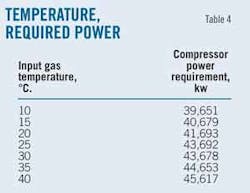COMPRESSOR OPTIMIZATION—1: Energy recovery guides natural gas pipeline system efficiency
View Article as Single page
Operational conditions
Simulating a station using HYSYS software and existing data allowed study of changing operating conditions on compressor station performance , including the pressure drop in scrubber and air coolers (Fig. 1).
The following conditions governed the simulation:
• Flow rate passing through the station, 80 MMscfd.
• Input gas pressure, 700 psi.
• Output gas pressure, 1,000 psi.
Table 4 shows input gas temperature's effect on compressor station power under constant pressure conditions for each period. Decreasing input gas temperature allows pressurization with smaller amounts of power. Each 1° C. decrease in input gas temperature causes roughly a 0.5% decrease in required power.
A scrubber causes pressure drop of 5-6.5 psi when clean and 18.5-24.5 psi when dirty. Compressor station simulation calculations show a 5 psi pressure drop reduces power requirements by 850 kw. Each 1 psi drop decreases compressor power requirements by 0.39%.
Compensating for the pressure drop caused by air coolers requires increasing compressor station pressure. Holding both input gas pressure to the compressor and the output gas pressure from the station constant, each 1 psi pressure drop caused by air coolers increases power requirement by about 0.27%.
Sensitivity analysis
Sensitivity analysis used a gas thermal value of 36,000 kilojoule/cu m and gas turbine efficiency of 32% (based on the average of installed compressors) to investigate solutions for decreasing compressor power requirements. Cooling input gas by 1° C. yielded roughly 55,000 cu m/year gas savings.
Researches also investigated pressure drop in the scrubber stemming from nonobservance of design principles and, in some cases, failure to replace the scrubber filter in a timely manner. Table 5 shows scrubber pressure drop's effects on turbine performance.
This article only investigates pressure drops up to 25 psi, but field observations show drops as large as 30-50 psi in scrubbers.
Study included investigating reduced pressure drop in air coolers, holding input gas pressure to the compressor and output pressure from the station constant. Calculations show each 1 psi pressure drop in air coolers saving 315,000 cu m/year of natural gas.
Energy loss
Determining energy balance is the best way to compare design conditions and optimum operational conditions and to calculate energy loss.
After investigating global energy consumption norms in gas transfer projects and determining the essential indices and parameters affecting operational conditions, researchers sought to determine energy loss points and determine energy savings potentials.
Investigating efficiency of selected compressor stations along the three pipelines showed it to be lower than designed. Some stations with 10-25 Mw gas turbines installed were producing <4 Mw, prompting a 3-year study to determine energy loss by each station component. Investigating turbine efficiency showed that only Siemens turbines closely approximated to design operations.Other turbines had lower performance in most cases (Fig. 2).
Turbines lose most of their power through the exhaust system. Investigation showed Siemens turbines losing less than others through this path.
Displaying 2/5
View Article as Single page



